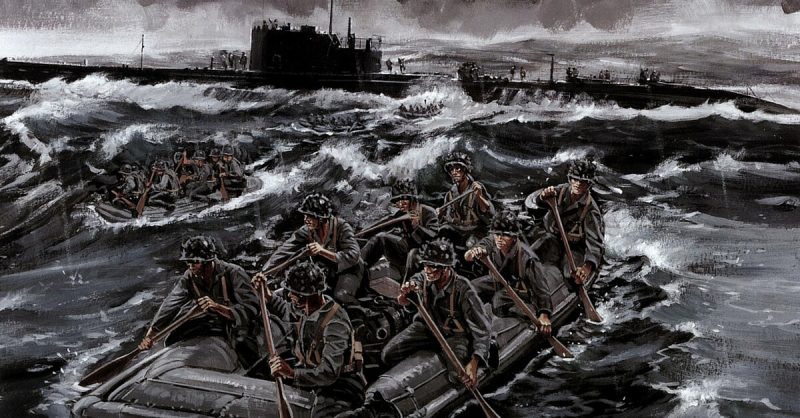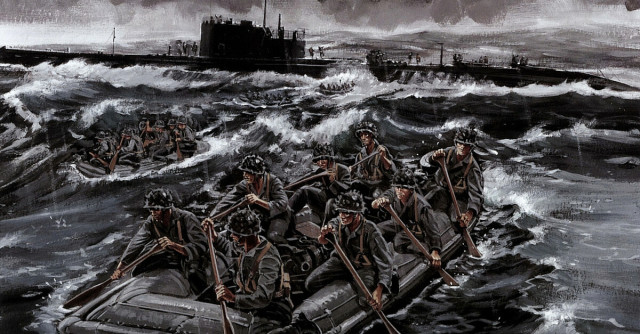By: Lars Erik Gill
“The most detailed account of the raid ever written.”
-Benjamin F. Carson – B Company, 2nd Marine Raider Battalion
The few that even care to know about the raid that took place during 17th and 18th August 1942 in the Gilbert Islands call it the ‘Makin Island Raid.’ In reality, there is no island called Makin.
The island that is referred to as Makin Island is, in fact, the island of Butaritari. The island is a flat sandy island that is part of a 16.3km atoll in the Gilbert Islands located north of the Tarawa Atoll. During World War Two (WW2) it would see both a United States Marine Corps (USMC) raid in August 1942 and a United States Army invasion the following year in November 1943. Soon after the attack on the American naval base at Pearl Harbor the Imperial Japanese Army (IJA) and Naval (IJN) forces began a campaign of expansion into the Far East and Pacific areas.
The Gilbert Islands would be just another area captured by the Japanese forces. Butaritari was expanded into a large seaplane base as part of the Japanese outer ring of defenses. The atoll was manned by a mixture of personal and from there. Japanese reconnaissance aircraft would fly long range missions to monitor all Allied air and sea movements in the South Pacific area as well as using the island to refuel their aircraft along with minor repairs. The few Europeans that lived on the island had been evacuated when the Japanese Gilberts Special Naval Landing Force arrived on 9th December 1942. This force was one detached from the 51st Guards Force that had its base on Jaluit Island that was to occupy Marakei, Abaiang, and Butaritari. The Japanese left soon after and returned on Christmas Eve 1942, this time with the intention to stay.
The few Europeans that were there along with Coastwatcher’s were rounded up. Recovering from the attack on Pearl Harbor it took some time before the American forces were in a position to strike back against the relentless advance of the Empire of Japan. The first American landing was to take place on the island of Guadalcanal in the Solomon’s Island chain on 7th August 1942. Codenamed Operation Watchtower, the United States Marines of the 1st Marine Division landed successfully and would go on to capture their objective, the airfield.
At the same time another secret operation was to take place in the Gilbert Islands. Butaritari Island was to be raided by the 2nd Marine Raider Battalion. Its mission was to gather intelligence, take prisoners, destroy installations and, if possible, the aircraft located on the island. This raid was intended to be conducted to create a diversion for the Japanese who had most of their attention focused towards Guadalcanal and the Solomon Islands chain, if successful would work as a diversion to draw Japanese forces away from the Solomon Islands.

The Marine Raiders were to sail undetected in two submarines the USS. Nautilus SS-168 and USS. Argonaut SM-1. The mission called for a landing on the island under the cover of darkness using Landing Craft Light Rubber (LCLR) boats. Lieutenant Colonel (Lt. Col.) Evans F. Carlson, the 2nd Raider Battalion’s Commander, would be summoned to Pearl Harbor in March 1942 to discuss and develop the plan of action.
Both Attu Island, Aleutian Islands and Guam in the Marianas was considered. However, they were deemed too far away to have any effect on troop movements to current operations on Guadalcanal and sufficiently reduce the Japanese forces that were occupying these Islands. Butaritari Island was chosen due to its small numbers of defenders, many of whom were non-combatants, which it was anticipated that the two Raider Companies could overwhelm.
The Japanese garrison on the island consisted of seventy-three seaplane support personnel currently stationed on the island and a detachment from the 61st Guard Force Dai 61 Keibitai led by Sergeant Major (Sgt. Maj.) Kanemitsu from the IJA. It is not known for certain to this day if other Japanese units were on the island and perhaps perished in the ensuing raid?
Task Force 7.15.3 arrived off the Island of Little Makin just to the north of Butaritari on 16th August after completing a nine-day fully submerged trip from Pearl Harbor. On board the submarines no one had known for sure if this was a real mission or just an exercise up to this point. The Marine Raiders in the submarines had been organized into 11 men boat teams, just as they had practiced on the 14th they opened the submarine hatches and inflated their LCRL boats at 03:30 hours. The wind was strong; the surf was high, and it was also raining.
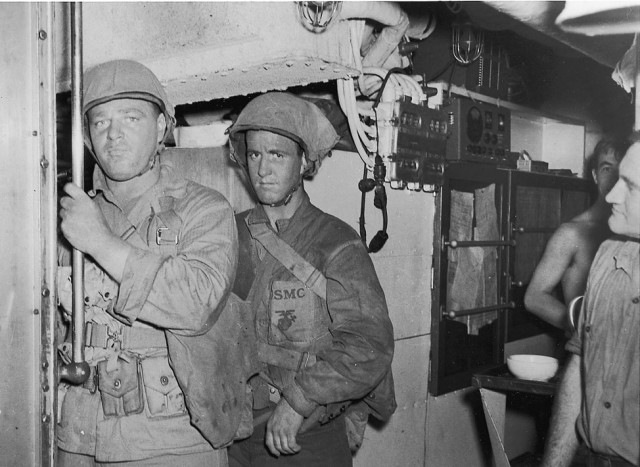
With difficulty, the submarines moved to within 500 yards from the reef line. Spirits were high at this point, weapons, ammunition, medical supplies, fuel and the heavy motors that was to power the boats were hauled onboard. These would quickly be lost due to heavy surf and no ropes being attached to any of the boats to keep them secured together. It all took a longer time than the rehearsals and rather than let the submarines submerge under the boats they were instead lowered down the sides.
One of the boats containing several machine guns along with the medical supplies was swept away by the heavy waves. With all boats loaded by 03:40 hours and the twenty boats from the two submarines met they headed for the landing beach by 04:15 hours. After battling swells, wind and current the two companies landed at a beach over a 100 yard stretch. The two companies had originally planned to land on their allocated beaches that were 3000 yards apart, but this was later abandoned.
They had landed slightly off the landing site of B Company’s beach Z and was ordered to run to the correct beach. Orders were passed by word of mouth. 1st Lieutenant (1st Lt.) Oscar Peatross commander of B Company was nowhere to be found. 1st Lt. Peatross had been separated along with his 11 man crew while heading for land. He had at one point had Lt. Col. Carlson in his boat who had actually suffered a cheek injury while boarding and later transferring to another boat crew.
The rain had finally stopped, and boats were camouflaged with palm fronds in the tree line. Everyone was ashore by 05:00 hours as planned with the exception of three boats could not be accounted for. Until this point there were doubts about whether the Japanese were aware of the Raiders landing? Those doubts were ended at 05:30 hours when Private First Class (Pfc.) Vern Mitchell of A Company accidentally fired his Browning automatic rifle. This incident only added to the situation already going wrong.
For the first and only time in his military career Lt. Col. Carson swore at one of his men, understandable considering that this incident could have jeopardized the element of surprise and placing the operation at risk. At 05:43 hours Lt. Col. Carlson reported to the USS Nautilus via radio ”Everything lousy”…
As dawn broke Lt. Col. Carlson shook off his anger and ordered his Raiders of A Company, which landed in the area designated for B Company, to go across the island to the lagoon and take their objectives that was originally intended for Company B. At this point scouts confirmed that they were Indeed on Beach Z and Lt. Col. Carlson radioed that the situation had improved.
One Raider was dropped off every 50 yards to guide B Company forward. Some of B Company’s men had already moved ahead towards their objectives when landing, this made matters confusing. In their sector B Company had also progressed and was moving ahead together with the machine gun section of A Company and crossed the island. Corporal (Cpl.) Cotton how was leading the machinegun section of A Company and positioned a machinegun and mortar position just beyond the Government House to cover a field of fire for his advancing men.
Included in the defensive position were the Boys anti-tank rifle crews were placed amongst them. The Raiders of 1st Platoon, A Company were greeted with a bang when members of B Company fired a shotgun at the incoming men believing that they were the enemy. Thankfully nobody was hit. The area around was secured and friendly natives that greeted the Raiders. They told the men that most Japanese forces were located near On Chong’s Wharf over 2000 yards away to the southwest. Their numbers were estimated at 75 to 200. Some other friendly fire in incidents happened, but no one was hit.
At this point, it was clear that the Japanese knew they had visitors on their island! The sun was shining brightly at dawn when 2nd Lieutenant (2nd Lt.) Wilfred S. LeFrancois the commander of 1st Platoon A Company. Leading his men in a V formation down the Lagoon Road towards the Japanese-held area in the process passing the native hospital on their way. Every hut and building along the way was cautiously cleared.
The very first man to spot the Japanese soldiers was Cpl. Howard Young. A truck with approximately 20 Japanese soldiers stopped 300 yards down the road, and the men jumped out having planted a flag moved into the surrounding brush and undergrowth on both sides of the road. Some more Japanese arrived on foot. Sergeant (Sgt.) Clyde Thomason arranged his squad into a horseshoe formation to trap the oncoming Japanese into their ambush.
It was now 06:30 and in a scene that was reminiscent of the World War One (WW1) the Japanese advanced across open ground with fixed bayonets straight into Sgt. Thomason’s deadly prepared ambush killing ground. Sgt. Thomason opened fire with his shotgun followed by the whole platoon opening up with Thompsons, BARs and rifles killing most of the oncoming Japanese. A Boys anti-tank gunner destroyed the truck engine with a single round of .55in.
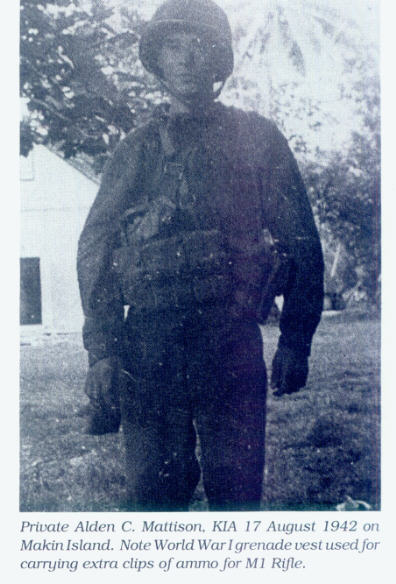
The Japanese returned fire with first two, eventually all four machine guns along with their rifle grenade launchers and rifle fire from men hidden in the bushes. 2nd Platoon knocked them out by swinging to the right and flanking them. The 2nd Platoon also took casualties suffered nine dead which was mostly from rifle fire and would go on to capture two heavy Japanese machineguns. It was all over in under 30 minutes, however the Raiders were pinned down by sniper fire for over two hours. Lt. Col. Carlson at his command post (CP) inland from the beach ordered the 1st Platoon B Company to reinforce the men at the Lagoon Road.
Japanese snipers tried to pick out the squad leaders and radio operators, several were hit. Corpsman quickly ripped off their Red Cross armbands as not to be obvious targets! While directing fire for his men Sgt. Thomason was killed by a snipers bullet after exposing himself in an attempt to draw Japanese fire away from his men. He would be the first Marine of WW2 to be awarded the Congressional Medal of Honor. Among the dead was also the intelligence officer Captain (Cpt.) Gerald Holtom. 1st Lt. Joe Griffith, the commander of 2nd Platoon B Company, wanted to advance his unit up the road to have better sight and control however Lt. Col. Carlson ordered them into a skirmish line.
The situation dragged on until 11:30 hours. 1st Lt. Peatross men had become isolated having landed approximately one mile southwest of Lt. Col. Carlson due to the effects of the surf and currents. Disorientated along with his 11 men that had landed with him he accidentally put himself and his men in a position that would eventually become the Japanese rear. He could not make out his position until they spotted the Japanese rifle range after heading down the beach and inland, in the process finding the two washed away boats on their way.
1st. Lt. Peartoss was planning his move when Pfc. Mitchell fired his rifle by accident northeast of his position. He concluded that the shot had compromised his position and had alerted the Japanese who would investigate the site to find out what the situation was, this would as transpired, place him and his men to the rare of the Japanese. He responded by moving his men closer toward the Japanese positions. He could not contact the rest of the force as his handy-talkie had become waterlogged.
He sent two men by different routes to attempt contact with Lt. Col. Carlson. They reached Lt. Col. Carlson, who was relieved by the news about 1st Lt. Peatross and his men. He gave no further orders nor sent a runner back with any additional information or message. When advancing near some barracks, a lone Japanese soldier ran out and everybody opened fire in what 1st Lt. Peatross would later describe as a classic example of overkill!
Two more Japanese were killed when they tried to ride off on their bicycles. 1st Lt. Peatross deployed his men in a skirmish line near the lagoon road and after killing three Japanese soldiers in quick succession, they crossed the lagoon road and approached what was believed to be the Japanese Headquarters (HQ) on the island however the building was abandoned. Then after spreading out to secure the area Cpl. Sam Brown shot a Japanese soldier bursting out in shorts, white shirt and a pith helmet. They found out later that this was no other than Sgt.Maj. Kanemitsu himself. Now the enemy had lost their commander.
At Lagoon Road Japanese snipers had taken their toll on Raiders when suddenly shouting and a bugle sounded through the air. What was to come would go down as the Battle for the Breadfruit Trees. The Japanese rushed the Raider positions in a Banzai charge. To the screams of ‘Tehoheka banzai’! Together with automatic fire sounded all across the island. In this battle six more Raiders would lose their life. Cpl. B. Earls of B Company, after suffering a head wound went on what many would later describe as mad and broke away from the Raiders that were holding him down, charged the Japanese positions, killing several before himself was gunned down.
Some said he was mad, but some said he was just “damn angry.” A group of ten Japanese soldiers attempted another charge under covering fire, but were quickly killed at short range. It had taken only a few minutes and organized resistance ended shortly after 11:30 hours. There were now only a few Japanese snipers left to harass the two companies of men near Stone Pier. Lt. Col. Carlson, on the other hand, had problems of his own and was worried about his progress, and he decided to commit parts of B Company to his reserve and he told 1st Lt. Griffith to deploy the men into a skirmish line further up.
Lt. Col. Carlson kept his men on a straight line. He did not want his two companies to advance due to lack of intelligence on the defending force. He had already won a decisive victory but he would not be aware of this and, therefore, did not act on it. The first day at Butaritari was not going according to plan for Lt. Col. Carlson. The Japanese abandoned their assaults in the area of the breadfruit trees and in Butaritari`s mid interior.
While Lt. Col. Carlson and his men were dealing with snipers, 1st Lt. Peatros and his 11 men had progressed and mounted an attack on the Japanese to the west killing eight enemy soldiers for the loss of three dead and two wounded Raiders. They also destroyed the radio station and a moving automobile while keeping the pressure on the enemy’s rear.
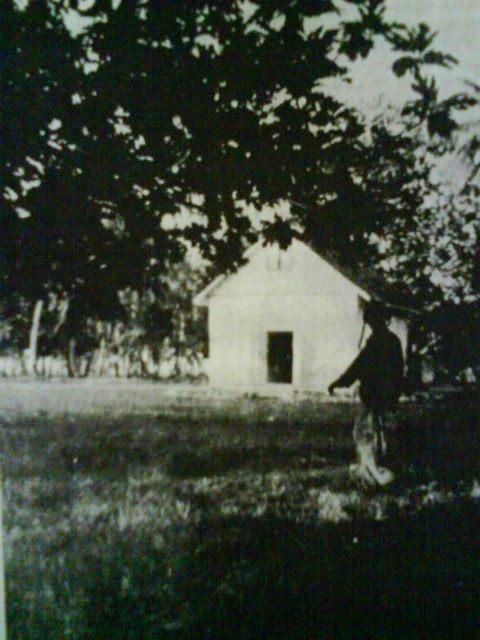
Using hand grenades they destroyed a truck full of weapons that had USMC markings on it. This was captured on either Guam or Wake Island. 1st Lt. Peatross later earned the Navy Cross for his actions having blowing up and killed as many Japanese as they could. They had now stopped as they were only around 400 yards from the main body of men.
All that day Lt. Col. Carlson walked to and from the frontline from his CP. Evaluating the situation and visiting individual Raiders, giving them a motivating word and cheering them up. Major (Maj.) James Roosevelt was Lt. Col. Carlson’s executive officer (Ex.O.) and second in command. Maj. Roosevelt was the son of the President, stayed at the CP helping the coordination between the companies.
Ammunition was sent forward and an aid station had been set up. The wounded were piling up and some were in serious condition. A few Japanese snipers had managed to sneak through the Raider lines and at one point Maj. Roosevelt had to return fire himself. He was graze on the finger by a bullet but later rejected a Purple Heart.
While the Raiders fought on land, the two submarines that had brought them to Butaritari spent the morning submerged one mile out to sea and were monitoring the skies for enemy aircraft. The USS. Nautilus had also been shelling the Ukiangong Village that lay 8000 yards to the southwest end of the island with its deck gun as Japanese reinforcements were believed to be in that area.
Maj. Roosevelt had also ordered the shelling of two vessels in the lagoon moored near On Chong’s Wharf. This was a transport ship and a gunboat. It was feared that the transport was carrying reinforcements for the Japanese Combined Fleet. USS. Nautilus opened fire at 07:16 hours and ceased fire 07:23 hours. Over sixty-five rounds were fired and sunk the ships. Though this was done Lt. Col. Carlson was worried. He had heard from natives that about sixty Japanese Marines had disembarked from the ships that had just been sunk. However this could not be verified.
What had happened to the crews of these ships has remained a mystery? Some may have come ashore but there are no mention of them anywhere. After the Breadfruit Battle about 11:30 hour’s two lone Nakajima E8N Type 95 ‘Dave’ reconnaissance aircraft arrived. Both of the submarines dove quickly after spotting them on radar and the Raiders took cover. After observing Butaritari from the air for about fifteen minutes the two aircraft dropped two bombs neither of which hit Raider lines. They then turned around and disappeared.
The danger was over and at 12:55 hours the USS. Nautilus surfaced and picked up on their radar another group of aircraft approaching from the north. They did not manage to alert Lt. Col. Carlson and his Raiders because of faulty radio communications. The USS. Nautilus immediately submerged again and in the process managed to alert the USS. Argonaut. The twelve aircraft included two Kawanishi H8K ‘Emely’ Type 2 large flying boats, four Kawanishi E7K1 Type 94 ‘Alf’ recon float planes, and four Mitsubishi A6M Type 0 ‘Zero’ with two more Nakajima E6N2 Type 95 ‘Dave’ seaplanes came at 13:20 hours.
After about seventy minutes of strafing and bombing the Raider lines and positions although doing little damage. Ten aircraft disappeared and a Japanese ‘Emily’ and a ‘Dave’ seaplanes landed in the lagoon a 1000 yards from the shore off Kings Wharf. The Raider took up positions and took aim with their anti-tank rifles and machine guns. The Platoon Sergeant, Sgt. Victor Maghakian, nicknamed ‘Transport’ who was one of the legendary old China Marine veterans of A Company directed three machine guns along with the two Boys anti-tank rifles near Kings Wharf and opened fire with tracer ammunition.
The Dave seaplane busted into flames and sank as it taxied in and the Emily made a speedy turn to avoid the fire. It tried to take off, but in the attempt to avoid the Raiders fire, it pulled up too sharply and stalled. It hit the lagoon and exploded into flames. Sgt. Maghakian did his job well. The Emily burned and settled into a mooring area the wreck can be seen to this day. Both aircraft where destroyed. Once again Lt. Col. Carlson had heard rumors from the natives about Japanese reinforcements pouring out of the seaplane. The Emily flying boat was capable of carrying 40 passengers; the natives stated that 35 Japanese had escaped the wreck.
With the air attack over Lt. Col. Carlson conducted a withdrawal towards the two submarines later in the afternoon. With the enemy snipers holding up the Raiders in their front line Lt. Col. Carlson decided to pull back into an open ground area in hope that the snipers would follow and make them easier to dispose of. This maneuver was started at approximately 14:30 hours. Shortly after the withdrawal at about 16:00 hours the Japanese aircraft again arrived over Butaritari and for the next thirty minutes they bombed and strafed the Raider positions.
As Lt. Col. Carlson had hoped the enemy troops moved forward after the Raiders withdrawal and now found themselves under attack by friendly aircraft. As shrapnel and bullets shattered palm trees the Raiders took cover while the Japanese snipers took a beating of their own for over thirty minutes. When the final aircraft departed from the island Lt. Col. Carlson had to make an important decision. Either remain in his position and take out the rest of the defenders and then pull back to the beaches to depart in the submarines, or he could order an immediate withdrawal as suggested by Maj. Roosevelt.
After assessing the frontline situation and asking other officers of their opinions he agreed to Maj. Roosevelt`s initial suggestion. He made no further attempt to complete his mission. It would only be a question of time before the Japanese could arrive with reinforcements. At 17:00 hours Lt. Col. Carlson sent some Raiders back to the beaches to ready the LCRL boats for the evacuation from the island. In the meantime Lt. Col. Carlson ordered the rest of his men to begin carefully pulling themselves back from the front line. At this crucial point in time Lt. Col. Carlson decided to pull back even though the mission to destroy enemy forces and installations had not been completed.
Meanwhile in the mid-west section of Butaritari 1st Lt. Peartross and his men had to make their own decision. 1st Lt. Peatross also decided to pull back same as Lt. Col. Carlson and then head out to the submarines. They destroyed anything that could be of value to the Japanese on the way and headed towards the beach. Sometime between 18:40 and 18:45 hours the Raiders started to pull back from their defensive lines towards the beaches where other Raiders had readied the LCRL boats for them. By 19:00 hours a guarding force covered the beachhead to prevent any Japanese attack.
They were to wait until the Raiders had left and take the last boat out. The Raider gathered themselves in small groups and most of them were assembled and ready by 19:10 hours. The wounded where placed in a different boat to improve the chances of the wounded making it back to the submarines. The waves pounded the beach and the surf was high. Another incident at the beach sent the force including Maj. Roosevelt running for cover as Pfc. Bauml accidently fired his rifle next to Maj. Roosevelt.
The plan was to leave Butaritari at 19:30 hours and to use the darkness as cover by 19:15 hours the boats had lined up along the shoreline on the southern beaches. The Raiders spread out and walked the boats out to waist deep water and started to paddle toward the pickup point with the submarines in a long string of boats. The last two boats was for Lt. Col. Carlson’s command group and the rearguard. He was to board the last boat however failed to order the rearguard to withdraw. Some blamed an unidentified NCO for giving the orders.
The Raiders had problems with the high surf and several boats were knocked over including Maj. Roosevelt`s boat. The process took hours and exhausted Raiders and were tossed up on the beach again and again become too tried to paddle thought the rough surf. Also roomers of sharks spread around the Raiders although it was never confirmed, a Raider supposedly told other Raiders that he had been bitten.
One man believed to be Cpl. James Beecher went into the water screaming ‘shark’ and disappeared. His body was later recovered by the Japanese. Lt. Col. Carlson watched helplessly as the battle between the Raiders and the surf unfolded. Most of the Raiders where without weapons and could do nothing to withstand an enemy attack. Many of them were also stripped to their underclothes. The rearguard squad waited patiently not knowing that there was no boat for them.
1st Lt. Peatross reached the USS. Argonaut, however where the other 120 men were was still a mystery to him at that moment. Those men were still at the beach having become exhausted after fighting the violent surf. Only four boats made it through with 53 men reaching the USS. Nautilus and three with 27 men made it to the USS. Argonaut a total of 80 Raiders in all. Lt. Col. Carlson watched his men and thought of what to do.
He set up a defensive line around the beach along with the rest of his 120 Raiders gathered at the beach with little equipment and weapons. They were forced to wait in the rain until dawn broke the next day to try another attempt. There were wounded and little medical support, his men were cold and they were nearly unarmed. As the day ended Lt. Col. Carlson faced a problem. He had no idea how to reach the two submarines safely. At 23:00 hours fire was heard from the guarding Raiders.
A patrol of eight Japanese approached the line. Three were killed by Pfc. Jess Hawkins of B Company. He himself was wounded by two shots to the chest and later died but he forced the rest of the Japanese patrol to retreat. Lt. Col. Carlson held a meeting with his officers where several opinions and alternatives where considered. There was also the rumor of surrender. Among the men an “every man for himself” attitude lurked around.
According to 1st Lt. Peatross, Lt. Col. Carlson did contemplate surrender after consulting with his officers. Sending the unarmed Cpt. Ralph Coyte and Pfc. William McCall out to hand over a surrender note to the Japanese. Coyte said they found a lone Japanese sailor and gave him the note to deliver to a superior. The Japanese runner was shot by another Raider, reportedly with a pistol shot.
The men on Butaritari spent a miserable night on the island. Other options discussed by Lt. Col. Carlson and the officers was to either dash for the submarines or literally fight to the death. Onboard the USS. Nautilus 1st Lt. Peatross asked Commander (Cdr.) Haines for permission to take a ten men group to the beach to aid the remaining Raiders but he was turned down by Cdr. Haines and he stated that “the best thing to do was to wait until sunrise and determent the situation from there”.
The night went by and as dawn broke upon the Pacific Ocean on the 18th August Lt. Col. Carlson said that he would remain on the island that day with the wounded and move across the island to the lagoon and take his men to the submarines in native outrigger canoes at night. He added also that any man that felt strong enough to challenge the surf in the morning could so try.
Several groups of Raiders along the beach readied their LCRL boats and among them was Maj. Roosevelt. Approximately one mile out to sea the observers on the USS. Nautilus saw the activity on the beach and the submarine steered as close to the reef as it dared to shorten the distance for the men. The first boat arrived at the USS. Nautilus at 07:19 hours that morning and eighteen minutes later at 07:37 hours a second boat carrying seven men. After talking to an officer onboard one of the boats 1st Lt. Peatross recommended a rescue mission due to the information of possible surrender.
The rumors had reached the USS. Nautilus and 1st Lt. Peatross chose five men to join him, Sgt. Robert V. Allard, Sgt. Dallash H. Cook, Pfc. Richard N. Olbert, Private (Pvt.) Donald R. Robertson and Pvt. John I. Kerns. All were from B Company and had been instructed all of them to tell Lt. Col. Carlson that the submarines would submerge during the day to avoid air attacks by the Japanese however they would return at 19:30 hours for the final evacuation.
The volunteers left the USS. Nautilus at 07:40 hours and paddled to a point in the reef. One of them swam ashore with the message to Lt. Col. Carlson. A line throwing gun was fired to anchor the boat to shore. While this took place two other rubber boats bounced through the surf with several wounded men which included Maj. Roosevelt that Lt. Col. Carlson had ordered off the island. They paddled towards the USS. Argonaut. Again the surf was too heavy and the boat rolled over and tosses the Raiders in it into the water.
Again they waded up to the beach. They tried again and this time filled the boat half full of water so that the extra weight would keep them from rolling over. Using palm fronds and rifle butts to paddle to the submarines their effort paid off and arriving at 08:00 hours just minutes before another air raid by the Japanese. Maj. Roosevelt and the other men in the boat just managed to reach the USS. Nautilus just before she slipped beneath the waves as a bomb explosion from the Japanese aircraft shock the surface. The Japanese fighters strafed the messenger boat and some Raiders ashore thought both that the LCRL boat and the USS. Nautilus had been sunk.
No one was harmed in the incident, this incident occurred at 09:30 hours. The submarines remained submerged during the day. Lt. Col. Carlson held a little ‘Gung Ho meeting’ named after the battalion’s motto and attempted to rally his men. At this time he also send out patrols across the Island to locate any enemy forces and look for lost Raiders. They set alight a thousand drums of aviation fuel near King’s Wharf along with recovering Japanese documents from their HQ. Natives provided fresh coconut milk and water.

They also counted the bodies of both American and Japanese. The count came to eighty-three Japanese at the Breadfruit Trees site along with eleven Raiders. Another thirty Japanese were found near the lagoon road and they also counted three dead Raiders that had been with 1st Lt. Peatross. Fifty Raiders had managed to reach the submarines that made the number of Raiders with Lt. Col. Carlson on the beach considerably smaller. Lt. Col. Carlson gave orders to put the raid back on track again.
He explained that they were to cross the island and relocate near Government House then to withdraw through the lagoon. Lt. Col. Carlson readied his force for evacuation and knew what fate it would have if the plan backfired. Japanese reinforcement where certain to arrive soon? In exchange for some weapons a few trench guns and ammo and $50 Lt. Col. Carlson arranged with the Chief of Police on Butaritari, a native, Joseph Miller that the fourteen Raiders was to be buried. Lt. Col. Carlson sent 1st Lt. Lamb and two other Raiders to inspect a forty-foot sloop located off Stone Pier.
They were greeted with rifle fire and in the process killed the sailor with a hand grenade. The boat was taking in water and could not be used. The Raiders had to use their LCRL boats as originally planned. They had also two native outriggers at their disposal. At 18:10 hours the submarines surfaced and headed towards the rendezvous point where the submarines were waiting for their signals from Lt. Col. Carlson at 19:30 hours.
They made contact using a flashlight when Sgt. McCullouh climbed a palm tree. He flashed out signals to meet at Flik Point at the Lagoon`s south entrance at 23:00 hours. The Raiders now paddled out in a string with one motor on the front boat. The ten men in the LCRL boat to the far right wanted to paddle on their own as they said that progress was to slow. Lt. Col. Carlson being a very democratic leader approved. This decision would cost them their lives when they cut themselves loose and they were never seen again. Neither their names nor a headcount was taken.
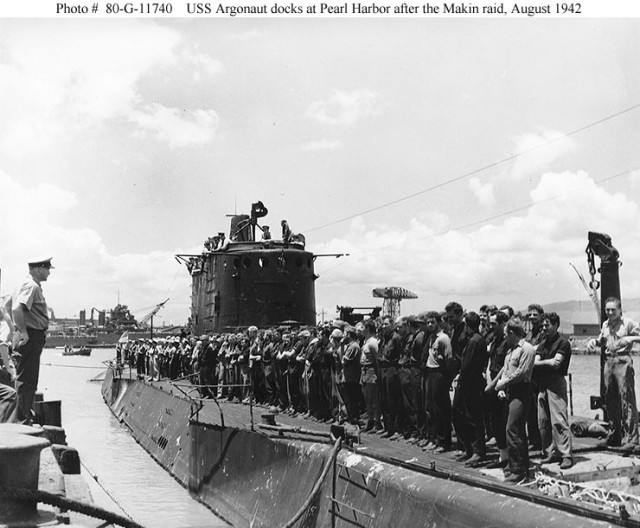
The “Nautilus” arriving at Pearl Harbor, Hawaii on August 26th 1942 after the raid
Finally at 23:08 hours Lt. Col. Carlson and his men were pulled up alongside the submarines. The submariners helped them onboard with search lights on and the wounded being loaded first. The Raid on Butaritari had lasted for 43 hours. Headcounts were made, and a death had to be confirmed by at least two Raiders.
The men that cast off alone were thought to have boarded the USS. Argonaut and Lt. Col. Carlson reported to Cdr. Haines that he was satisfied with all numbers. As the corpsmen worked frantically on the wounded the two submarines set a course for Pearl Harbor, Hawaii at 23:58 hours where they would receive a hero’s welcome on 26th. August 1942.
Lars Erik Gill
Kristiansand, Norway
